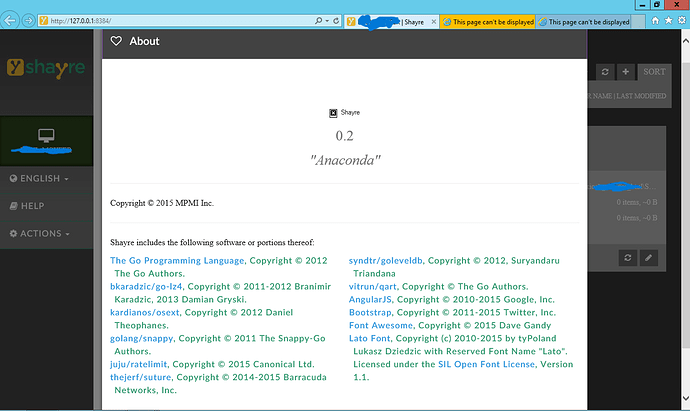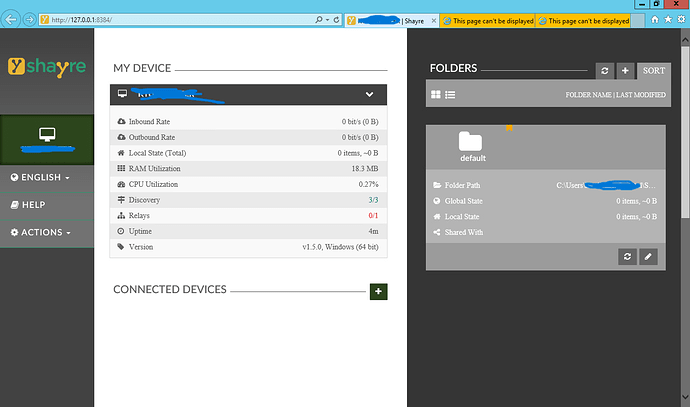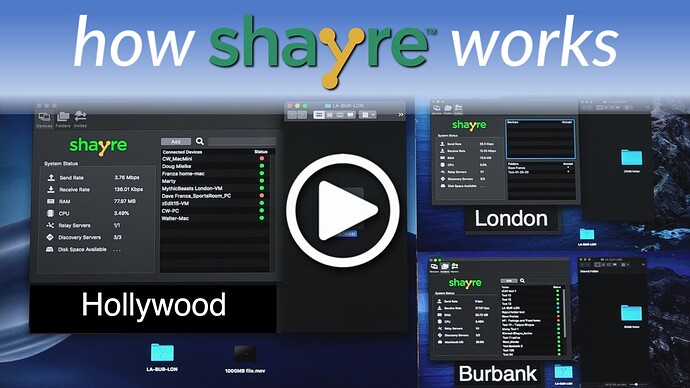So I work in broadcast television for an ABC affiliate, and I couldn’t help but notice their Shayre software looks very very similar to Syncthing. I don’t see any references to Syncthing but the interfaces and functionality is so similar it cannot be a coincidence. Thoughts?
I can’t find a trace of it on the internet. Is this something you pay for?
Ok, found it, seems like shayre.com is the website.
I guess this is against the license and just pure bastard move to rebrand and charge for opensource.
Apart from the general asinieness of rebranding without actually doing much unique/of their own (looks like a desktop UI/wrapper?), in my understanding of the MPL the only thing they need to do is inform recipients of their “software” how to obtain the source - I doubt they do that but it hardly matters, one can bury that info easily such that it might as well be inexistent. And of course they’d need to make changes open, but I don’t expect them to do anything that “involved”.
This isn’t something we pay for but something local ABC affiliates are provided with, by ABC, to distribute their promotional content. Obviously, this is a commercial application but I didn’t ask about it on their end, I doubt their support people are even involved in the application development process. Not accusing of anyone of stealing code, just trying to understand the connection between this two nearly identical pieces of software.
The interface and dates on the screenshots look very old. Syncthing was switching licenses at that time, and one of them was MIT. Maybe they simply took the MIT-licensed code and rebranded it as their own?
For the record, this is what their current interface appears to look like.
“How much stockphotos and marketing gibberish do you want?”
“Yes”
It might look like this on a Mac but the screenshots I posted are from an installation I’m currently in the process of doing and it is the latest version for Windows.
How on earth the installed version is 0.2 (first screenshot) while “My device” in screenshot 2 shows version 1.5.0?
Let’s say they did fork the MIT version of Synthing…
Keeping quiet about the relationship to syncthing is a d*ck move, but understandable, given that this service doesn’t seem to provide anything that Syncthing doesn’t.
Another issue I see is whether or not they are using Syncthing infrastructure to keep their service running.
They appear to be using their own relay servers and there is some sort of Slack API that is utilized.
If the devs for Syncthing aren’t calling foul, I guess it’s all good. I’m not going to jump to conclusions about anything and I just hope they are contributing to the further development of Syncthing since they’re obviously using this as a commercial application.
They didn’t, though, because the about dialog contains things added only afterwards; for example the line about credit to go-lz4 which was added in pr 2109 at which point the source was MPL. So at minimum it’s a license violation if they’re not publishing the source code.
It’s certainly based on some old version, but not old enough to avoid the MPL.
I’m calling foul, I just don’t have the energy or teeth to do much about it.
The license also says they can’t remove the copyright in the source files. They did that, or ours would still be visible on the about page.
They only need to send a copy of the code to their actual customers, don’t they though? This means that unless the OP’s company asks for it, it will likely remain inaccessible. Otherwise the software isn’t even available to download without an account, and it seems extremely niche overall, i.e. there is barely any information about it on the Internet, with searches leading almost only to their website ![]() .
.
Yeah, source “must be made available” and “recipients of the Executable Form” “must be informed” how they can obtain it, so they don’t need to inform us how unless we get the executable.
However
You may not remove or alter the substance of any license notices (including copyright notices, patent notices, disclaimers of warranty, or limitations of liability) contained within the Source Code Form of the Covered Software, except that You may alter any license notices to the extent required to remedy known factual inaccuracies.
so yeeting our entire presence from the about dialog, which is contained within the source code form, seems prohibited. (I don’t see the above applying solely to comments that are not present in the executable form.)
Yeah, it’s obvious they’re trying to market this as their own product with no mentions of Syncthing at all (e.g. searching for site:shayre.com syncthing on Google brings up nothing).
I think it would be interesting to see the log (if it’s even available to the end user).
I wonder if just a email would be enough. The owner of the fork is clearly in the wrong, and I’m certain would lose any legal challenge, so smartest move would be just to close shop.
Ripping out (“yeeting” per @calmh) all references to the source looks intentionally dodgy – hard to argue you didn’t intend to deceive.
So they are not complying with the license, which is a copyright violation, and a willful violation, which is very serious, with hefty penalties. If one were inclined, and hired the right lawyer, the Syncthing Foundation could be well funded for the future. [1]
On the other hand, they are [supposedly] providing support for their users, which is non-trivial. As a first approach, I don’t think shutting them down would be in the best interest of anyone. It might bring some moral satisfaction, but it would create a lot of ill-will to the Syncthing Foundation and project for taking away a useful tool from users who have been willing to pay for the [rebranded] product and support.
Rather, getting the company to voluntarily bring themselves into compliance with the license should be a win for Syncthing and a win for the company and their customers. If their customers are happy with the product and the support, why deprive them of it? Certainly some of their customers will jump ship for the free version. But many will likely opt to keep paying for the support that they get.
As I see it, the company needs to 1) publish the source code and 2) credit the source (Syncthing). Making amends to Syncthing by making some donation(s) to the foundation would not be out of order either.
There are surely a lot of improvements that the Syncthing project have added since this company forked their version; by coming into compliance with the license they could benefit from more recent code. And Syncthing could gain some helpful contributions from a company with a vested interest in ensuring that the project thrives. [2]
This is the sincerest form of flattery; lets see if we can make this into a win-win for everyone.
On the other hand, if they don’t want to do this the easy way by doing what’s right and abide by the law, then I am sure that there are lawyers happy to take this on, and that the Foundation’s bank account would be most appreciative of the result.
Chapter 5 - Circular 92 | U.S. Copyright Office “Remedies for Infringements: Damages and Profits”
The copyright owner is entitled to recover the actual damages suffered by him or her as a result of the infringement, and any profits of the infringer that are attributable to the infringement and are not taken into account in computing the actual damages. In establishing the infringer’s profits, the copyright owner is required to present proof only of the infringer’s gross revenue…
[1] A violation of the project license means that legally, the violator no longer has permission of the copyright owner to distribute the project and therefore is now in violation of copyright law by copying and distributing it. This is a “clever hack” of copyright law to create the “copyleft”.
[2] if they are continuing to copy source code and remove copyright and credit, then that indicates another whole level of willfulness, suggesting that someone is not dealing in good faith. It is also possible that this has been perpetrated by an internal or contracted developer and the suits do not realize the copyright violation that is going on.
I am not an expert by a wide shot on any of this, I am just reading the license and some info around it. And based on that I am wondering what exactly people are considering in breach of the MPL here (not in breach of it’s spirit)? Our license is very permissive. I only see one possible infringement:
There UI elements look extremely similar to ours (icons, structure, …). So likely they did re-use code there, meaning they need to make those changes availabe to recipients of their product (meaning not the public). I doubt they do that, but we can’t know.
Removing any mention of Syncthing from their product/about page - totally allowed. See Q19 on the MPL FAQ (MPL 2.0 FAQ — Mozilla):
Section 3.4 prohibits most changes to license notices that are seen when looking at the source code. We do not encourage changing licensing and notice statements which are displayed when the software is executed. However, such changes are permitted by the license, so that source code can be reused between software with very different user interfaces.
So really they can take our code, create their own UI or even strip our UI of any mention of Syncthing, ship that to customers and in some part of a contract or something fulfill the license requirement by disclosing the copyright and making source available. Don’t think that’s nice or honest, but I also don’t think it’s illegal. We’d need to go with a full copyleft license to prohibit that like something from the GPL suite.


